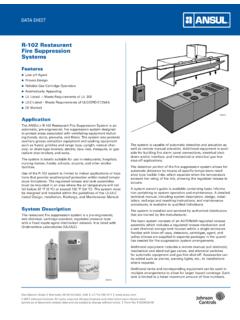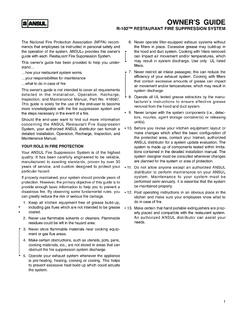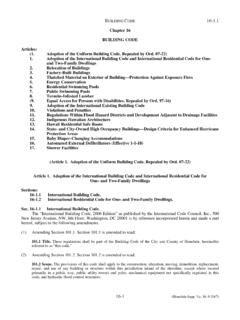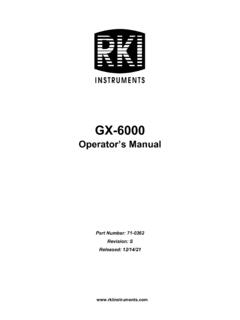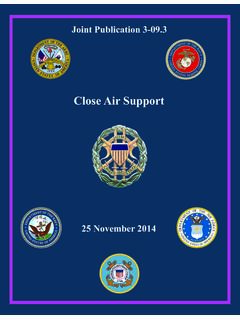Transcription of SAFETY STANDARD FOR HYDROGEN AND HYDROGEN …
1 NSS Aeronautics and Space AdministrationSAFETY STANDARD FORHYDROGEN AND HYDROGENSYSTEMSG uidelines for HYDROGEN System Design, MaterialsSelection, Operations, Storage, and TransportationOffice of SAFETY and Mission AssuranceWashington, DC 20546iPREFACEThis SAFETY STANDARD establishes a uniform Agency process for HYDROGEN systemdesign, materials selection, operation, storage, and transportation. This standardcontains minimum guidelines applicable to NASA Headquarters and all NASA FieldCenters. Centers are encouraged to assess their individual programs and developadditional requirements as needed.
2 Shalls and musts denote requirementsmandated in other documents and in widespread use in the aerospace STANDARD is issued in loose-leaf form and will be revised by change and questions concerning the contents of this publication should bereferred to the National Aeronautics and Space Administration Headquarters,Director, SAFETY and Risk Management Division, Office of the Associate for Safetyand Mission Assurance, Washington, DC D. Gregory Effective Date: , 1997 Associate Administrator forSafety and Mission AssuranceiiiACKNOWLEDGMENTSThe NASA HYDROGEN SAFETY Handbook originally was prepared by Paul M.
3 Ordin,Consulting Engineer, with the support of the Planning Research Corporation. Thesupport of the NASA HYDROGEN -Oxygen SAFETY Standards Review Committee inproviding technical monitoring of the STANDARD is acknowledged. The committeeincluded the following members:William J. Brown (Chairman)NASA Lewis Research CenterCleveland, OHHarold BeesonNASA Johnson Space CenterWhite Sands Test FacilityLas Cruces, NMMike PedleyNASA Johnson Space CenterHouston, TXDennis GriffinNASA Marshall Space Flight CenterAlabamaColeman J. BryanNASA Kennedy Space CenterFloridaWayne A.
4 ThomasNASA Lewis Research CenterCleveland, OHWayne R. FrazierNASA HeadquartersWashington, DCThe special contributions provided by Grace Ordin are noted. Also acknowledgedare the contributions provided by Carol A. Vidoli and, particularly, William of NASA Lewis Research Center for their aid in reviewing, organizing, andediting this handbook; Fred Edeskuty of Los Alamos National Laboratory forinformation on slush HYDROGEN , and William Price of Vitro Corporation for hisrevision. This revision was prepared and edited by personnel at the NASA JohnsonSpace Center White Sands Test Facility.
5 This document was extensively reviewedby experts at the various NASA centers, and their comments and suggections wereinstrumental in making the manual as complete and accurate as possible. Theexpertise of these professionals in the area of HYDROGEN system hazards, materials,selection, design, and operation is gratefully THIS DOCUMENTThis document and its companion document, SAFETY STANDARD for Oxygen andOxygen Systems (NSS 1996), are identified as Tier 2 Standards andTechnical Requirements in the NASA SAFETY and Documentation Tree (NHB ).
6 The information presented is intended as a reference to HYDROGEN design andpractice and not as an authorizing document. The words shall and must areused in this document to indicate a mandatory requirement, and the authority for therequirement is given. The words should and will are used to indicate arecommendation or that which is advised but not information is arranged in an easy-to-use format. The reader will find thefollowing useful to note: A numbered outline format is used so information can be readily found andeasily cited.
7 An index is provided in Appendix H to assist the reader in locating informationon a particular topic. Acronyms are defined when introduced, and a tabulation of acronyms used in thedocument is provided in Appendix F. The figures and tables referenced in the text are located in the appendices. All sources are referenced so the user can verify original sources as deemednecessary. References cited in the main body of the text can be found inChapter 10, and references introduced in an appendix is cited in that latest revisions of codes, standards, and NASA directives should be usedwhen those referenced are superseded.
8 The International System of Units (SI) is used for primary units, and USCustomary units are given in parentheses following the SI units. Some of thetables and figures contain only one set of OF CONTENTSP aragraph PageCHAPTER 1: BASIC HYDROGEN SAFETY GUIDELINES100 SCOPE1-1101 INTRODUCTION1-1102 APPLICABLE DOCUMENTS1-5103 PERSONNEL TRAINING1-5104 USE OF INHERENT SAFETY FEATURES1-7105 CONTROLS1-9106 FAIL-SAFE DESIGN1-10107 SAFETY1-10108 WAIVER PROVISIONS1-11 CHAPTER 2.
9 PROPERTIES AND HAZARDS OF HYDROGEN200 TYPICAL PROPERTIES2-1201 TYPES OF HAZARDS2-3202 FLAMMABILITY AND IGNITION OF HYDROGEN2-14203 DETONATION2-24204 CHARACTERISTIC PROPERTIES OF GH22-29205 CHARACTERISTIC PROPERTIES OF LH22-35206 CHARACTERISTIC PROPERTIES OF SLH22-36 CHAPTER 3: MATERIALS FOR HYDROGEN SERVICE300 CONSIDERATIONS FOR MATERIALS SELECTION3-1301 HYDROGEN EMBRITTLEMENT3-7302 THERMAL CONSIDERATIONS IN MATERIALS SELECTION3-11 CHAPTER 4: HYDROGEN FACILITIES400 SAFETY POLICY4-1401 SAFETY REVIEWS4-2402 GENERAL FACILITY GUIDELINES4-6viiiTABLE OF CONTENTS (continued)
10 Paragraph Page403 BUILDINGS AND TEST CHAMBERS4-12404 CONTROL ROOMS4-18405 LOCATION AND QUANTITY-DISTANCE GUIDELINES4-19406 EXCLUSION AREAS4-29407 PROTECTION OF HYDROGEN SYSTEMS ANDSURROUNDINGS4-32408 fire PROTECTION4-36409 DOCUMENTATION, TAGGING, AND LABELING OFSTORAGE VESSELS, PIPING, AND COMPONENTS4-39410 INSTRUMENTATION AND MONITORING4-42411 EXAMINATION, INSPECTION, AND RECERTIFICATION4-46 CHAPTER 5: HYDROGEN STORAGE VESSELS, PIPING, ANDCOMPONENTS500 GENERAL REQUIREMENTS5-1501 STORAGE VESSELS5-3502 PIPING SYSTEMS5-15503 COMPONENTS5-25504 OVERPRESSURE PROTECTION OF STORAGE VESSELS ANDPIPING SYSTEMS5-43505 HYDROGEN VENT AND FLARE SYSTEMS5-49506 CONTAMINATION5-55507 VACUUM SYSTEM5-60 CHAPTER 6: HYDROGEN AND HYDROGEN fire DETECTION600 HYDROGEN DETECTION6-1601 HYDROGEN fire DETECTION SYSTEMS6-9 CHAPTER 7.










